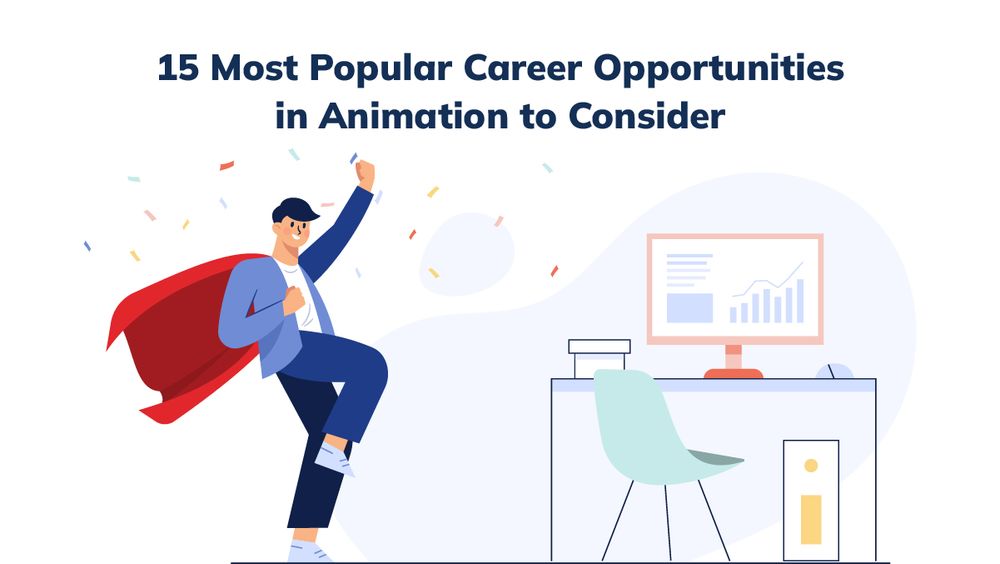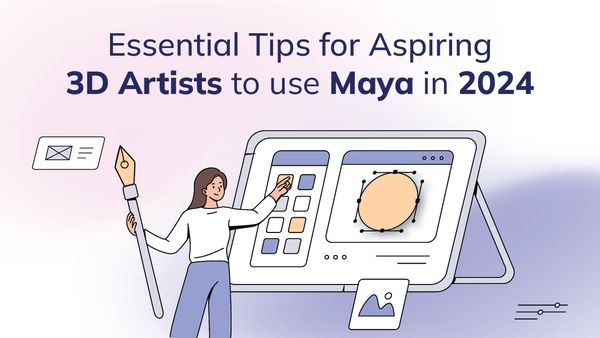15 Most Popular Career Opportunities in Animation to Consider
Creativity and imagination are combined in the animation field. If you have always enjoyed creative pursuits like drawing, illustrations, films, and even designing, the animation will tempt you to create something innovative! A degree in animation is just a ladder to get to the top. To get started, there are ample options that will give you technical skills and make you familiar with animation tools. The online animation courses with certificates like Autodesk Maya Lighting, Autodesk Maya Animation Essentials, Maya Modeling and texturing essentials, Zbrush and more will give you a clear picture of how it works.
The Career Opportunities for Animation are vast. All you need to gather is knowledge. A degree in animation will help you develop creative and technical skills most suitable for films and other creative and digital careers. The Animation Career Salary is pretty good, based on how you crack the interview. There is a massive demand for animators in various roles, you need to get hands-on experience in using and implementing the tools and techniques in the right way!
Also read: The Ultimate Guide to Animation
Top 15 Career Opportunities for Animation with Salary
1: Modeling Artist (Average annual salary of ₹ 3.0 Lakhs)
The role of a modeling artist involves using computer software to create and manipulate 3D models. They begin by creating a rough sketch or concept of the model they want to make and then use software such as Autodesk Maya, 3ds Max, or Blender to bring it to life. They use various tools to shape and sculpt the model, adding details and textures to create a realistic and believable final product.
Modeling artists also work closely with other production team members, such as animators and texture artists, to ensure that the models they create meet the project's specific requirements. They also collaborate with art directors and other creative professionals to ensure that the models fit the project's overall aesthetic.
Modeling artists must have a strong understanding of 3D modeling techniques and software, a good eye for detail, and a solid understanding of anatomy, lighting, and other technical aspects of 3D modeling. They should also have a good knowledge of the animation and video game industry and be familiar with the latest trends and techniques.
2: Texturing Artist (Average annual salary of ₹ 3.5 Lakhs)
A texturing artist, also known as a texture painter or a texture artist, is responsible for adding surface details, such as colour, patterns, and textures, to 3D models in animation, film, video games, and other digital media. They use specialized software to create detailed and realistic textures that give the models a sense of depth and realism.
The texturing artist works closely with the modeling artist and the rest of the production team to ensure that the textures they create align with the overall aesthetic and style of the project. They use their skills and knowledge of texturing, lighting, and materials to make the models look real. They also need to have a strong understanding of current trends and techniques in the industry to produce high-quality and realistic textures.
3: CG Animator (Average annual salary of ₹ 4.2 Lakhs)
A CG (computer-generated) animator is responsible for bringing animated characters, objects, and environments to life in film, television, video games, and other digital media. Using specialized software, such as Autodesk Maya, 3ds Max, and Blender, they create keyframe animations and motion capture data, then used to create realistic and believable movement.
CG animators work closely with other production teams members, such as modelers, texture artists, and lighting technicians, to ensure that their animation is consistent with the project's overall aesthetic. They also collaborate with directors and other creative professionals to ensure that the animation meets the project's requirements.
CG animators must have a strong understanding of animation techniques and software and a good eye for motion and timing. They should also have a good understanding of the animation and video game industry and be familiar with the latest trends and techniques in the field.
4: Layout Artist (Average annual salary of ₹ 3.0 Lakhs)
A layout artist, also known as a pre-visualization artist, creates detailed and accurate visual representations of scenes and sequences in animation, film, and video games. They use specialized software to create storyboards, animatics, and pre-visualization animations that help the director and other production team members plan out a project's visual elements. They work closely with the director, the animation team, and other production team members to ensure that the scenes they create align with the overall vision and style of the project.
The layout artist plays a crucial role in the early stages of the animation process, as they help to establish the project's visual language, camera angles, and overall look. They are responsible for creating detailed and accurate representations of the scenes and sequences, including the placement of characters, objects, and backgrounds. They must also understand animation principles, storytelling, and visual design to create compelling and believable scenes.
5: Rigging Artist (Average annual salary of ₹ 3.6 Lakhs)
A rigging artist creates a digital skeleton and controls characters and objects in animation, film, and video games. They use specialized software to build the underlying structure that allows animators to easily manipulate the movement and behaviour of the characters and objects in a scene.
A rigging artist closely works with the modeling and animation teams to ensure believable and natural movements; they need a strong understanding of anatomy, kinematics, and physics, as well as being familiar with the latest trends and techniques in the industry. Rigging is crucial in animation, allowing animators to easily manipulate characters and objects to create realistic and believable animations.
6: Simulation Artist (Average annual salary of ₹ 3.5 Lakhs)
A simulation artist creates realistic and believable special effects in animation, film, and video games. They use specialized software to simulate natural phenomena such as water, fire, smoke, and other physical products. They work closely with the animation and lighting teams to ensure that the effects they create align with the overall aesthetic and style of the project.
Simulation artists use various techniques and tools to create special effects, including particle systems, fluid dynamics, and rigid body dynamics. They also need a strong understanding of physics and mathematics to create realistic effects. They also use their skills and knowledge of texturing, lighting, and materials to make the effects look real.
The simulation artist plays a crucial role in the animation process, as they help to create an immersive and believable experience for the audience by adding realistic and dynamic elements to the scenes. They also need to be able to work under tight deadlines and be able to troubleshoot and problem-solve when necessary.
7: FX Artist (Average annual salary of ₹ 4.5 Lakhs)
An FX artist, also known as a special effects artist, is responsible for creating and animating visual effects for film, television, video games, and other forms of digital media. They use specialized software and techniques to create various products, such as explosions, fire, smoke, water, and other realistic simulations of natural phenomena. They work closely with the director, animation team, and other production team members to ensure that the effects they create align with the overall vision and style of the project.
FX artists have a strong understanding of physics, motion, and compositing to create believable and realistic effects. They use software such as Houdini, Maya, and Nuke to create simulations, particle systems, and compositing. They also use their creativity and artistic skills to design and implement effects that will enhance the visual appeal and storytelling of the project.
8: Compositor (Average annual salary of ₹ 5.2 Lakhs)
A compositor is responsible for combining and integrating the various visual elements of a film, animation, or video game into a final image or sequence. They use specialized software such as Adobe After Effects, Nuke, and Fusion to composite together elements such as live-action footage, 3D animation, special effects, and digital matte paintings. They work closely with the visual effects supervisor, the animation team, and other production team members to ensure that the final image or sequence aligns with the overall vision and style of the project.
Compositors ensure that all visual elements are properly aligned and integrated, adjusting color and lighting to create a cohesive final image. They also need to have a strong understanding of compositing techniques and software, a good eye for detail, and a solid understanding of color, lighting, and other technical aspects of compositing. They also need to be able to work under tight deadlines and be able to troubleshoot and solve technical problems as they arise.
9: Comic Artist (Average annual salary of ₹ 3.0 Lakhs)
A comic artist, also known as a cartoonist or illustrator, is responsible for creating visual storytelling through comics, graphic novels, and other related mediums. They use illustrations and text to tell stories and convey ideas in a sequential art format. They work on creating comics from the concept, sketching, inking, lettering, coloring, and sometimes publishing.
A comic artist typically starts by coming up with a concept or story idea and then proceeds to create rough sketches and layouts to plan out the visual elements of the comic. They use inking and drawing techniques to make the final illustrations, adding detail and texture to the characters and backgrounds. They may also be responsible for lettering, adding dialogue to the comic, and coloring the illustrations.
Comic artists need to have a strong understanding of storytelling, visual storytelling, and character design. They should be able to convey emotions, moods, and ideas with their illustrations and should be able to create characters that are both believable and engaging. Additionally, they should understand the comics industry well and be familiar with the latest trends and techniques.
10: Storyboarding Artist (Average annual salary of ₹ 3.5 Lakhs)
A storyboarding artist is responsible for creating visual representations of a script or story in the form of illustrations, called storyboards. These storyboards are used to plan and visualize the scenes and sequences of a film, animation, video game, or other digital media. They work closely with the director, writers, and other production team members to create visual representations of the script, which help to communicate the project's story, pacing, and visual style.
The storyboarding artist creates a visual plan for each scene, using illustrations to depict the action, camera angles, and character movements. They use their artistic skills to create compelling and visually interesting storyboards that capture the essence of the script. Additionally, they must have a good understanding of storytelling, visual design, and animation principles to create storyboards that effectively communicate the story and the desired visual style of the project.
11: Concept Artist (Average annual salary of ₹ 3.0 Lakhs)
A concept artist, also known as a visual development artist, is responsible for creating visual concepts and designs for characters, environments, and other elements in animation, film, video games, and other digital media. They use their artistic skills and imagination to create detailed and visually striking designs that help establish a project's look and feel. They work closely with the director, the production team, and other artists to ensure that the concepts they create align with the overall vision and style of the project.
Concept artists use a variety of mediums, such as traditional painting, drawing, and digital tools, to create their concepts and designs. They are responsible for creating various visual elements, including character designs, environment designs, props, and other assets. They must also understand art principles, visual storytelling, and animation and gaming industry trends to create engaging and believable concepts.
12: 3D Generalist (Average annual salary of ₹ 4.8 Lakhs)
A 3D generalist is a professional skilled in various 3D animation and VFX disciplines, including modeling, texturing, lighting, rigging, animation, and compositing. They create 3D assets and animation sequences for film, television, video games, and other digital media. A 3D Generalist understands the entire 3D production pipeline and can work on multiple tasks within a project, including modeling, texturing, rigging, animating, lighting, and compositing.
3D generalists strongly understand 3D software and techniques and can work efficiently and effectively with various tools and software. They can work independently or as part of a team and adapt to different styles and designs. They also need to understand the animation and VFX industry well and be familiar with the latest trends and practices in the field.
13: 2D Animator (Average annual salary of ₹ 3.0 Lakhs)
A 2D animator is responsible for creating animated sequences using traditional hand-drawn or digital techniques in animation, film, television, and other forms of media. They create keyframes, in-between frames, and final animation operating software such as Adobe Flash, Toon Boom, or TV Paint. They work closely with the director and other production team members to ensure that the animation they create aligns with the overall vision and style of the project. They also work with other animators, layout artists, and background artists to ensure that the animation is consistent and coherent.
The 2D Animator brings characters and objects to life by creating smooth and believable movements and expressions. They must understand animation principles, timing, and character acting to create compelling and believable animation. They must also have a good sense of design and composition to create visually appealing animation.
14: Character Designer (Average annual salary of ₹ 4.0 Lakhs)
A character designer is responsible for creating characters' visual appearance and looks in animation, film, video games, and other forms of media. They work closely with the director, writers, and other production team members to create visually appealing characters that align with the overall style and vision of the project.
The character designer begins by creating concept art and sketches of the characters, then used to create detailed and accurate 3D models. They are responsible for designing the characters' physical appearance, including their body shape, clothing, and accessories, as well as their facial expressions and body language. They must also consider the character's personality, background, and role in the story when designing their appearance.
The character designer works closely with the animation team to ensure that the characters they create can be animated effectively and that their movements are believable and expressive. They must also have a strong understanding of animation principles, visual design, and storytelling to create compelling and believable characters.
15: Lighting Artist (Average annual salary of ₹ 3.2 Lakhs)
A lighting artist is responsible for creating and controlling the lighting and mood of scenes in animation, film, and video games. They use specialized software and techniques to create realistic and believable lighting effects that help to enhance the overall look and feel of the project. They work closely with the rest of the production team, such as the modeling and texturing artists, to ensure that the lighting they create aligns with the overall aesthetic and style of the project.
The lighting artist is responsible for adding the final touches to the scene by adjusting the intensity, color, and direction of the lights to create the desired mood and atmosphere. They also need to consider the time of day and weather conditions to ensure the lighting is realistic and believable. They must also have a strong understanding of lighting principles, color theory, and visual design to create compelling and believable lighting effects.
Is Animation a Bad Career ?
Animation is a good career choice. It is a rapidly growing field with a wide range of career opportunities. The animation industry is diverse, with options in film, television, video games, digital media, and other fields. The demand for animation is high, as it is used in many forms of entertainment, education, advertising, and product design.
However, like any career, it has its own set of challenges. The animation industry is highly competitive, so it can be challenging to enter and find a job, especially with proper training and experience. It is also often demanding, with extended hours and tight, stressful deadlines. Additionally, animation jobs are only sometimes stable and may be subject to layoffs or budget cuts.
It is essential to be aware of these challenges and be prepared to work hard and be resilient. An excellent way to do this is by acquiring the proper skills and knowledge through an animation course, working on personal projects, and building a portfolio showcasing your abilities and creativity. Networking and building connections in the industry can also help find job opportunities.
Overall, career opportunities for animation can be rewarding and fulfilling for those passionate about the field, willing to work hard, and prepared to face the challenges it presents.




